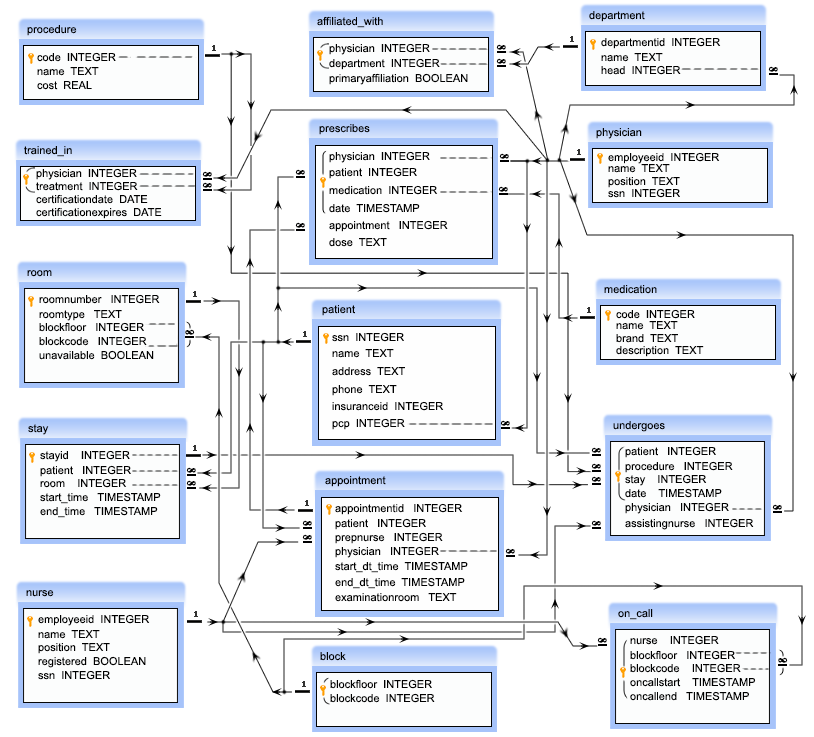SQL Exercise: Name of the patients, their block, floor, room number
28. From the following tables, write a SQL query to find the name of the patients, their block, floor, and room number where they admitted.
Sample table: staystayid | patient | room | start_time | end_time --------+-----------+------+---------------------+--------------------- 3215 | 100000001 | 111 | 2008-05-01 00:00:00 | 2008-05-04 00:00:00 3216 | 100000003 | 123 | 2008-05-03 00:00:00 | 2008-05-14 00:00:00 3217 | 100000004 | 112 | 2008-05-02 00:00:00 | 2008-05-03 00:00:00Sample table: patient
ssn | name | address | phone | insuranceid | pcp
-----------+-------------------+--------------------+----------+-------------+-----
100000001 | John Smith | 42 Foobar Lane | 555-0256 | 68476213 | 1
100000002 | Grace Ritchie | 37 Snafu Drive | 555-0512 | 36546321 | 2
100000003 | Random J. Patient | 101 Omgbbq Street | 555-1204 | 65465421 | 2
100000004 | Dennis Doe | 1100 Foobaz Avenue | 555-2048 | 68421879 | 3
Sample table: room
roomnumber | roomtype | blockfloor | blockcode | unavailable
-----------+----------+------------+-----------+-------------
101 | Single | 1 | 1 | f
102 | Single | 1 | 1 | f
103 | Single | 1 | 1 | f
111 | Single | 1 | 2 | f
112 | Single | 1 | 2 | t
113 | Single | 1 | 2 | f
121 | Single | 1 | 3 | f
122 | Single | 1 | 3 | f
123 | Single | 1 | 3 | f
201 | Single | 2 | 1 | t
202 | Single | 2 | 1 | f
203 | Single | 2 | 1 | f
211 | Single | 2 | 2 | f
212 | Single | 2 | 2 | f
213 | Single | 2 | 2 | t
221 | Single | 2 | 3 | f
222 | Single | 2 | 3 | f
223 | Single | 2 | 3 | f
301 | Single | 3 | 1 | f
302 | Single | 3 | 1 | t
303 | Single | 3 | 1 | f
311 | Single | 3 | 2 | f
312 | Single | 3 | 2 | f
313 | Single | 3 | 2 | f
321 | Single | 3 | 3 | t
322 | Single | 3 | 3 | f
323 | Single | 3 | 3 | f
401 | Single | 4 | 1 | f
402 | Single | 4 | 1 | t
403 | Single | 4 | 1 | f
411 | Single | 4 | 2 | f
412 | Single | 4 | 2 | f
413 | Single | 4 | 2 | f
421 | Single | 4 | 3 | t
422 | Single | 4 | 3 | f
423 | Single | 4 | 3 | f
Sample Solution:
SELECT p.name AS "Patient",
s.room AS "Room",
r.blockfloor AS "Floor",
r.blockcode AS "Block"
FROM stay s
JOIN patient p ON s.patient=p.ssn
JOIN room r ON s.room=r.roomnumber;
Sample Output:
Patient | Room | Floor | Block
-------------------+------+-------+-------
John Smith | 111 | 1 | 2
Random J. Patient | 123 | 1 | 3
Dennis Doe | 112 | 1 | 2
(3 rows)
Explanation:
The said query in SQL that retrieves the name of the patient, the room number they are staying in, and the floor and block of that room.
The JOIN keyword joins the patient table to the stay table based on the ssn and patient columns and the room table to the stay table based on the roomnumber and room columns.
Go to:
PREV : Find the floor with the minimum available rooms.
NEXT : Find the nurses and the block where they are booked.
Practice Online
E R Diagram of Hospital Database:

Have another way to solve this solution? Contribute your code (and comments) through Disqus.
What is the difficulty level of this exercise?
Test your Programming skills with w3resource's quiz.
